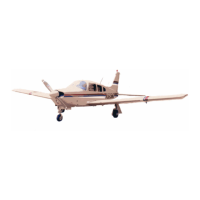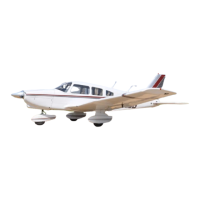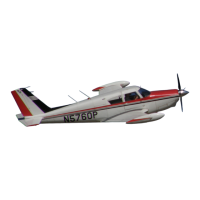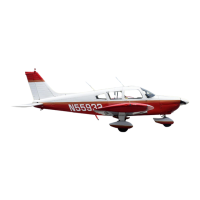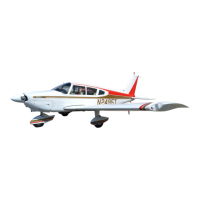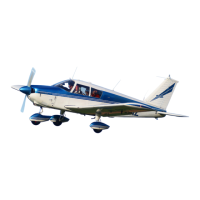LANCE II SERVICE
MANUAL
5-28. RIGGING
AND
ADJUSTMENT
OF RUDDER
CONTROLS.
a. To
check and set
the correct
degree of rudder
travel,
the following
procedure
may be
used:
1. Check the rudder
travel by swinging the rudder
until it contacts its stop. If the
control cables
are connected,
use the rudder
pedals to swing
the rudder.
2. With the rudder
against its
stop, place a rigging
tool against
the side of the
rudder
and vertical stabilizer
as shown in Figure
5-13. (Ascertain
that the tool is not contacting
any rivets.)
If no gap exists between the rigging tool
and the surface of the rudder and vertical
stabilizer, the rudder stop for
one direction of travel is correct as required
in Table V-I. (This
tool
may be fabricated from
dimensions given in Figure
5-22.)
3.
Swing the rudder
in the other direction
and check
travel as directed
in Step 2.
4. Should the rudder
travel be incorrect showing a
gap between the tool any any
part of the control
surfaces, the
tail cone fairing should
be removed and
the stops reset
to
obtain
correct
rudder travel.
(Refer
to Figure
5-14.)
b. To
set cable tension
and alignment
of
the rudder,
the following
procedure
may be
used:
1. Remove the
access panel to the aft
section of the fuselage.
2. Ascertain that
the nose gear
steering has been
aligned and rudder
pedals are
clamped together
in neutral position,
according to Alignment
of Nose Landing
Gear, Section
VII.
3.
Adjust the turnbuckles
in the aft
section of the fuselage
to obtain proper
cable
tension as given in
Table V-I and to
allow the rudder to
align at neutral position.
Adjust the
cables
evenly to
avoid uneven
strain on aircraft
components.
4.
Check
safety
of turnbuckles.
c. Adjust
the rudder
pedal stops by
pushing on
the pilot's left
rudder pedal
until the
rudder
stop is contacted.
Adjust the pedal
stop (on the fire wall)
to provide 0.06
to 0.120 of an
inch clearance.
Repeat the procedure
with the copilot's
right rudder pedal.
Do not push rudder
harder than necessary
to avoid cable
stretch.
d. Install the tail cone and the
access panel to the aft section
of the fuselage.
5-29. RUDDER
TRIM CONTROLS.
5-30.
REMOVAL
OF RUDDER TRIM
CONTROLS.
(Refer to Figure
5-15.)
a.
Remove the fuel selector panel cover
by removing the rudder trim knob (2),
cowl flap
knob on (PA-32RT-300T),
and the cover
attachment screws.
b. Place trim
knob (2) back
on assembly and
rotate to the
extreme left
(counterclockwise)
trim
position.
c.
Disconnect the
housing lug from
the arm on the
rudder pedal torque
tube by
removing cotter pin,
nut, washer and
bolt (7).
d. Remove the
threaded bushing
(4) from the aft end
of the mounting
channel (8) by
removing
cotter
pin and
clevis
pin (5).
e. The mounting
channel (8)
may be removed
by removing the
channel attachment
screws
inside of the channel.
The middle
and aft screws (9) need
only be turned
out while the
forward screw
(10) is secured
by a nut on the underside
of the tunnel.
To remove the forward
screw, lift the floor
carpet on the right
side of the tunnel adjacent
to the channel
and remove the
access
plate on the side
of the tunnel.
Secure the nut
and turn out the
screw.
Revised:
10/3/80
SURFACE CONTROLS
1G18
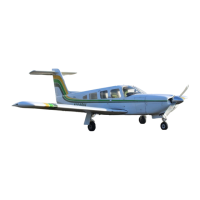
